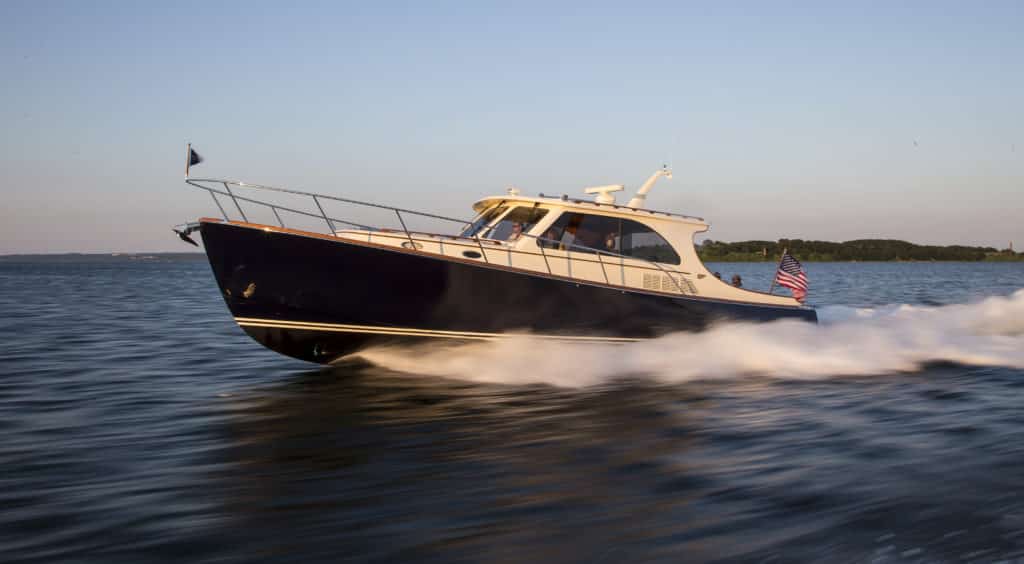
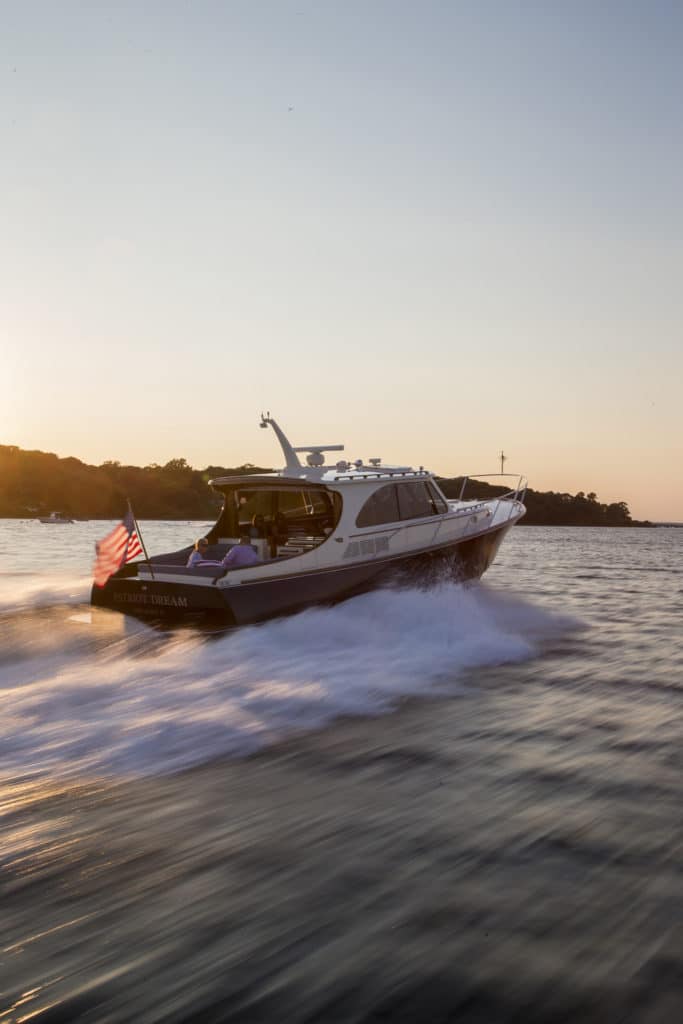
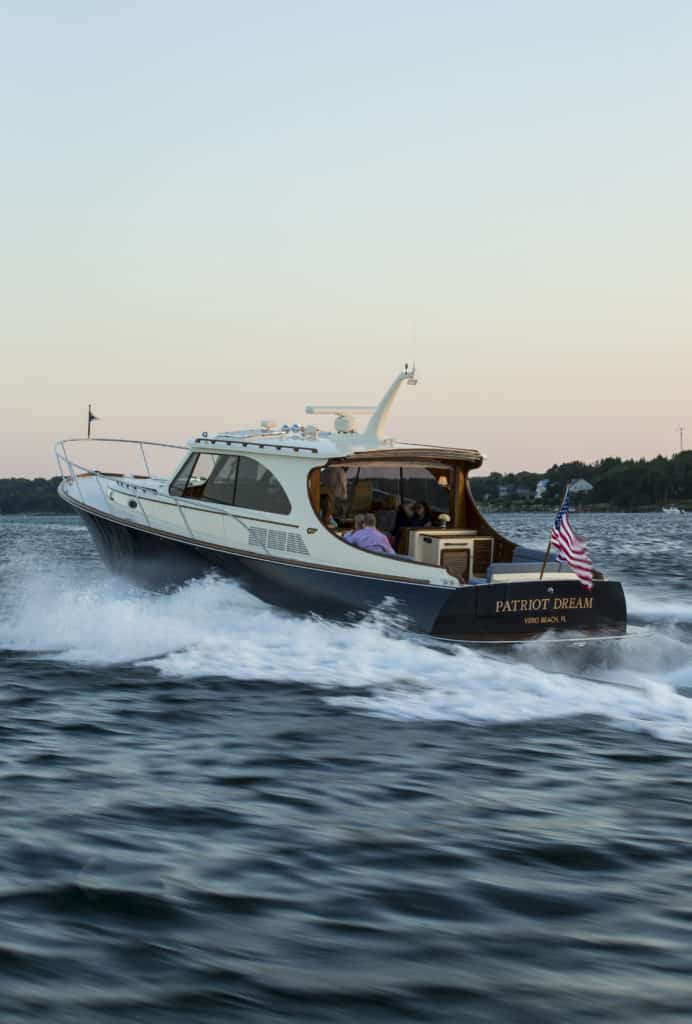
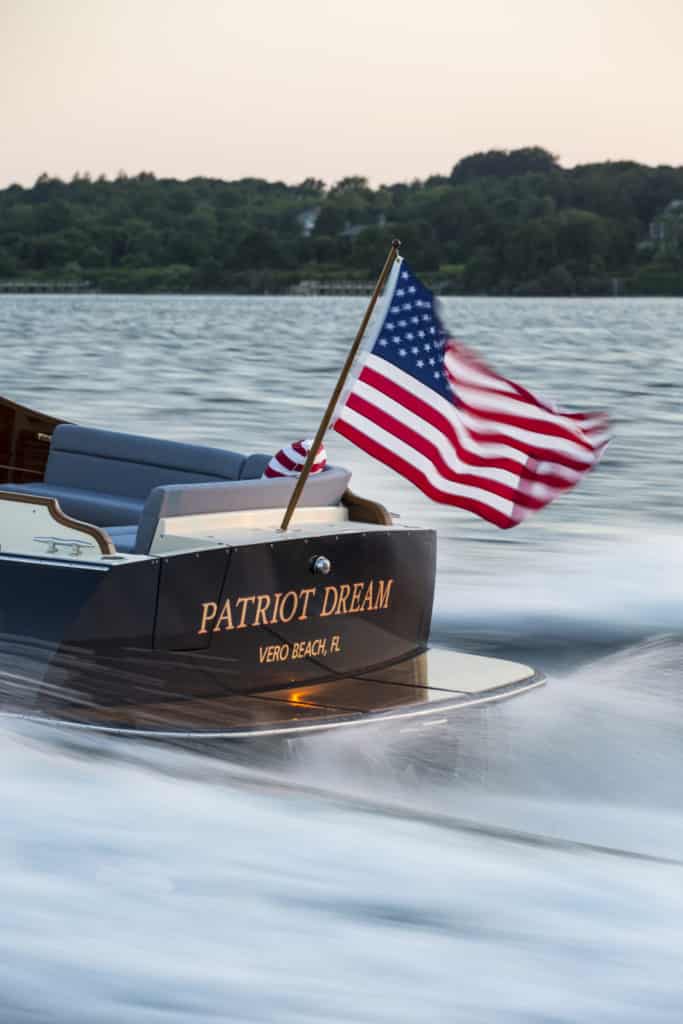
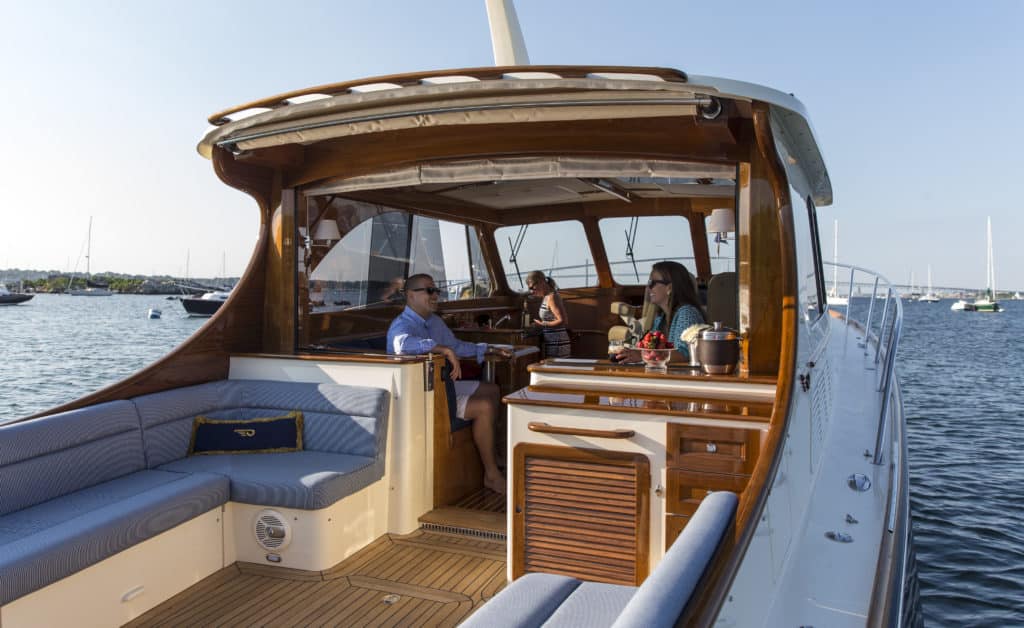
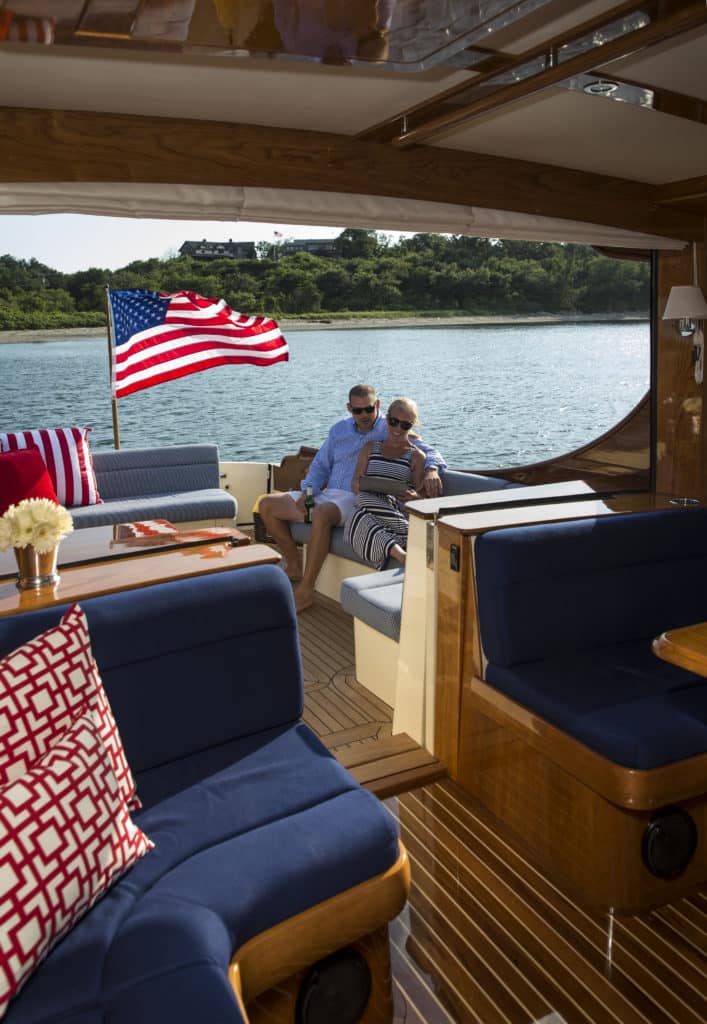
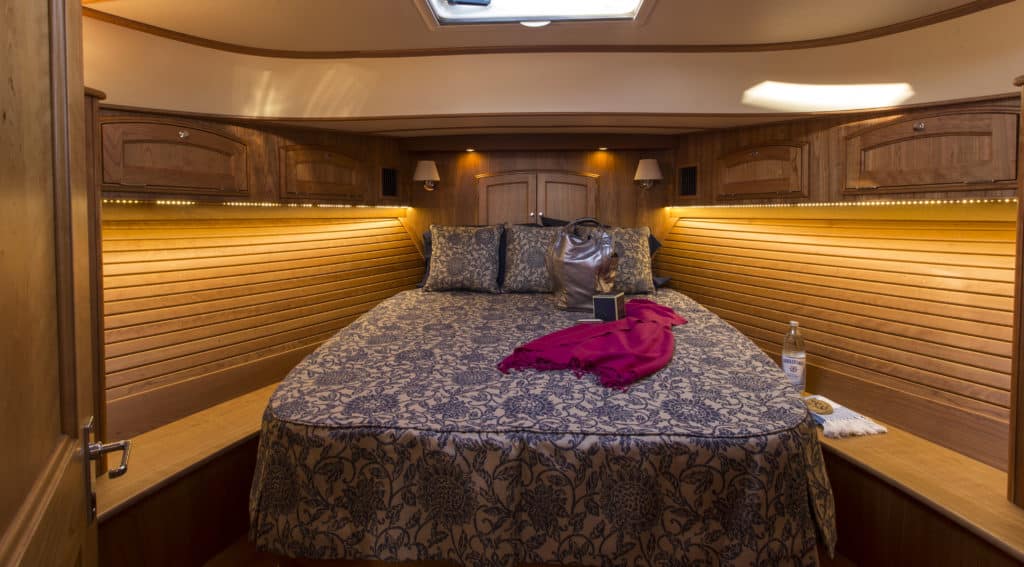
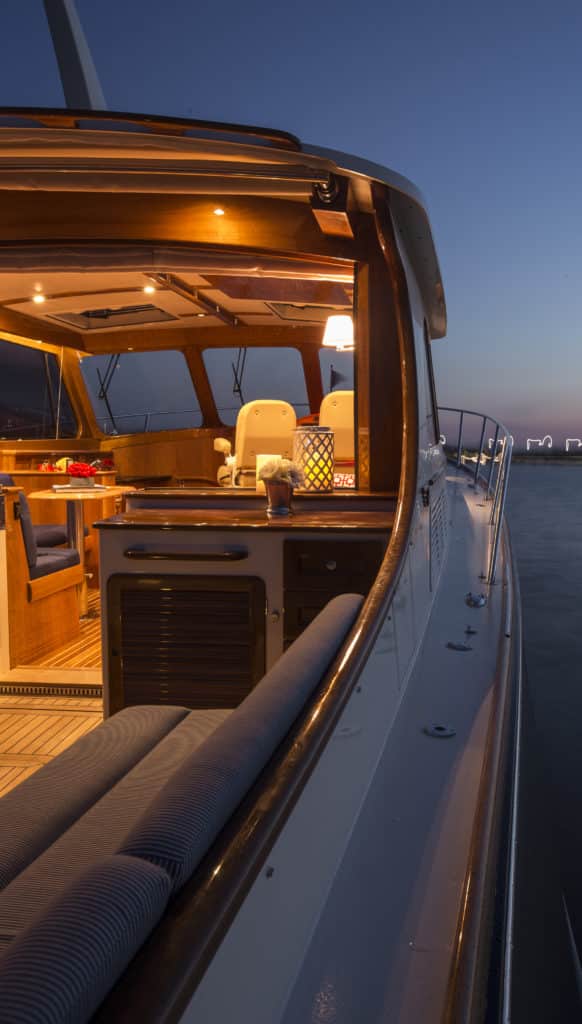
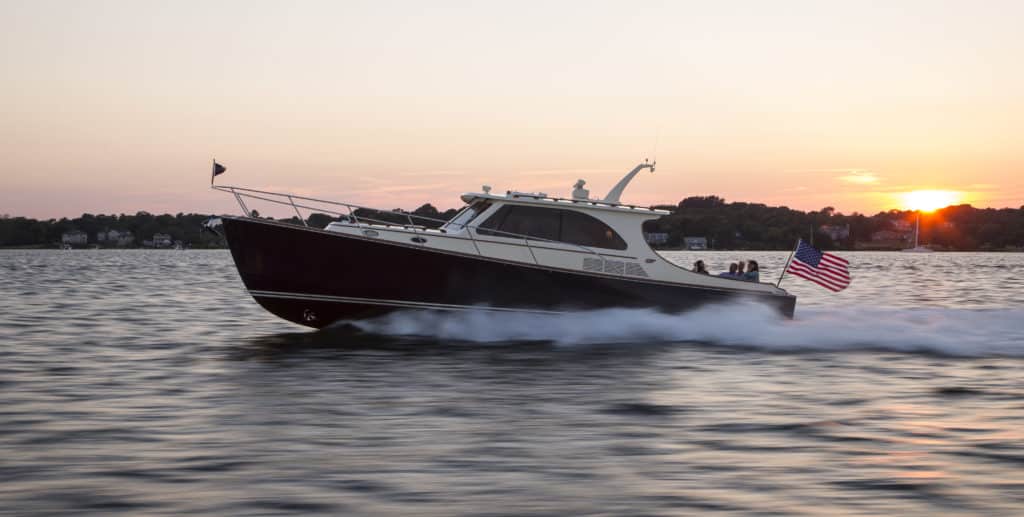
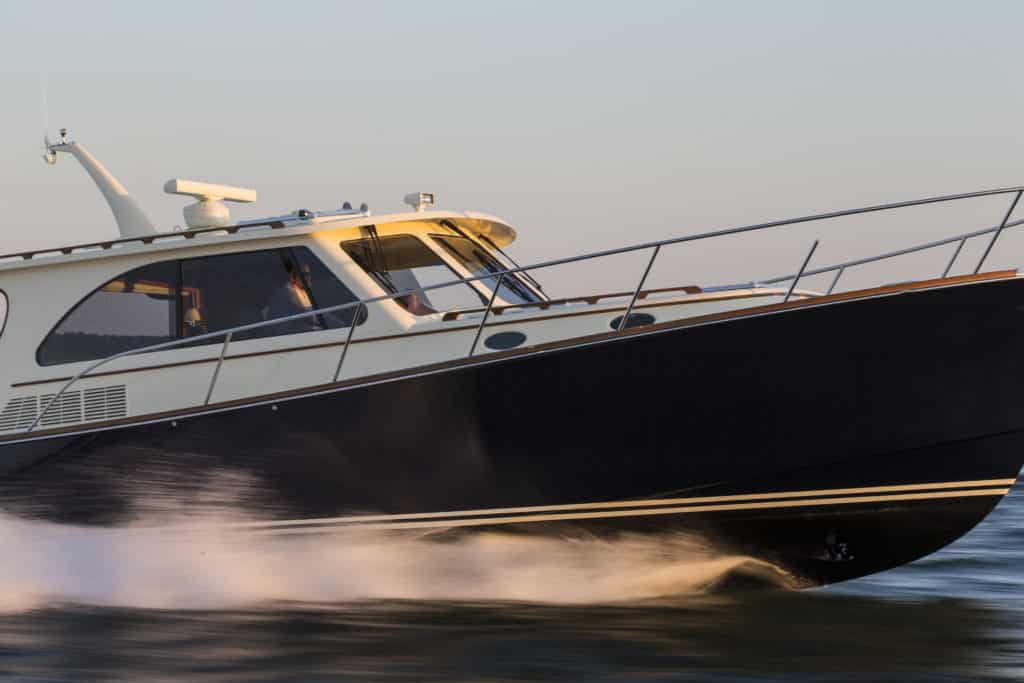
Breathtaking, I thought as I walked the docks of Dysart’s Great Harbor Marina toward Hinckley’s Talaria 43. And iconic. Even on a gray June day, the yacht stood out from all the other boats, a graceful Down East beauty. Plenty of [Hinckley][] ‘s yachts have cruised the waters in and around Southwest Harbor, Maine, since Henry Hinckley founded the company in 1928, and more than a few Hinckley owners have walked down this dock and laid eyes on the sculpted lines of a distinctive new yacht, eager to enjoy the always beautiful, yet sometimes punishing, North Atlantic waters where lobstermen ply their trade.
For an instant, my memory flashed back to the Picnic Boat ad that ran in YACHTING for several years. You know the one, with the boat afloat in a shallow pool of water, admired from her port stern quarter by a lucky owner and his dog. Everything about that image was riveting, from the warm late-afternoon light on the deckhouse to the eye-pleasing lines that spanned from stem to sensuous tumblehome aft. The attraction was palpable.
I was feeling that attraction again as the first writer to board Hull No. 1 of the 43 on the day of her official launch. And while the weather was less than perfect (I wasn’t going to get the chance to relive that shallow-water Picnic Boat moment), I was eager to take the helm. From the moment I boarded until she was tied up later in the day, I experienced the 43’s precision engineering, excellent handling and unparalleled fit and finish.
First, though, I settled into one of the cushy bench seats on the aft deck, a delightful place for a couple or a crowd of eight. Fine craftsmanship was all around me, from the optional hand-laid teak decking to the low, substantial wet bar and the deeply varnished teak toe rails milled to the builder’s trademark profile. My eyes were drawn to the three-pane glass wall spanning the aft cabin bulkhead, and I marveled at how well Hinckley fit it together without mullions.
Then a Hinckley technician inside flipped a switch, and all three panes lowered quietly into bulkhead recesses, two of which flanked the centerline door. The third recess was in the door, which then stowed to port in the bulkhead base, out of sight. In just moments, the Talaria 43 had transformed from an enclosed motoryacht into a design that felt like a cross between a hardtop and a sporty open express. Guests and family seated in the salon were immediately connected to those on the aft deck, as they would be in a home whose kitchen or family room opens onto a backyard pool and garden. The interior and exterior spaces connect visually as well as physically. The glass bulkhead, even when it’s raised to fend off rain or cooler temperatures, allows a feeling of being outside.
“That’s one of the design features we think makes the Talaria 43 a real game-changer,” said Jim McManus, Hinckley’s president and CEO. “In fact, we think it might be the perfect Hinckley because it’s configured in a way that people really want to enjoy their boats.”
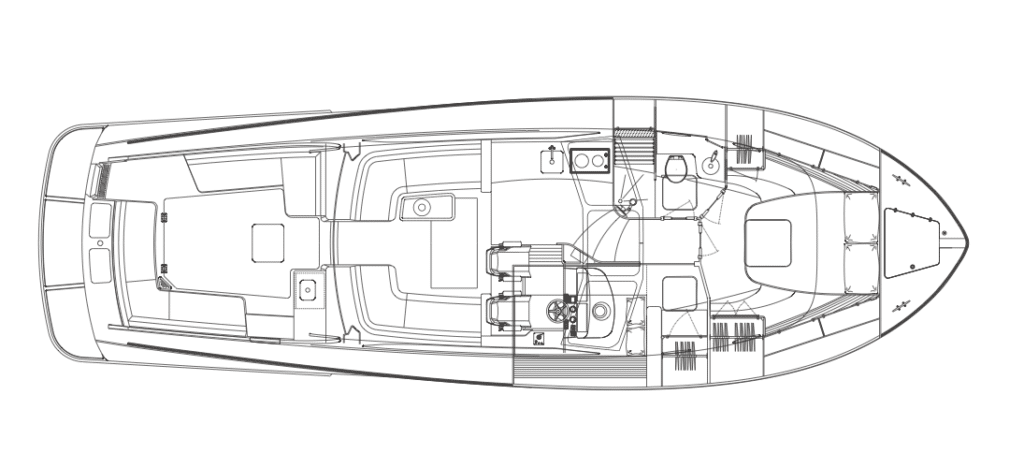
Inside, another seating area aft and a galley forward to port near the main salon are vital parts of that equation, keeping the hosts in constant contact with their guests when entertaining, or letting them share a moment more privately when preparing a meal for two while cruising. Large windows all around ensure nearly 360-degree views. Electronically operated overhead hatches and power sliding side windows let in fresh air, a particularly desirable addition in quiet, undisturbed coves when temperatures are mild and air conditioning is not required.
Before I left my seat on the aft deck, Hinckley’s representatives demonstrated two nifty options. The first was a drop-down, 32-inch LED TV that stows overhead inside the salon and rotates to serve viewers inside or outside. (I don’t know about you, but movie night under the stars is one of my favorite pastimes.) The other was a SureShade retractable Bimini top under the pilothouse hardtop that extends to protect more than two-thirds of the aft deck — creating a desirable respite for those who want to be outdoors but protected from the sun’s rays.
The Talaria 43 is equipped with Hinckley’s JetStick II, the latest iteration of the control system introduced in 1998. It makes handling in tight docking situations akin to child’s play. Being able to pivot easily within the boat’s length and to move in any direction with fingertip precision and control gave a whole new generation of Hinckley owners the confidence to explore new harbors, anchorages and marinas. The JetStick II stays true to the original’s simplicity of use and adds two features: Hover Lock, which provides station-keeping ability while waiting for a bridge or hanging lines and fenders short-handed; and Heading Hold, which enables hands-off control of rock-solid tracking at low cruising speeds.
With twin 550-horsepower Cummins QSB6.7 diesels rumbling quietly beneath the aft deck, we left the dock sideways, our drive controlled by the JetStick II that links the hydraulic bow thruster with a pair of Hamilton 322 jet drives. The ride was smooth and effortless with the buckets raised and the nozzles pointed aft. Options include twin 650-horepower Cat C8.7 diesels and twin 435-horsepower Volvo Penta IPS600 diesels with pod drives.
| Specifications | Builder Supplied Number |
|---|---|
| LOA: | 43’9″ |
| BEAM: | 14’6″ |
| DRAFT: | 2’4″ |
| DISPL.: | 32,770 lb. (full load) |
| DEADRISE: | 19 degrees |
| FUEL: | 500 gal. |
| WATER: | 100 gal. |
| ENGINES (std.): | 2 x 550 hp Cummins QSB6.7 diesels w/ Hamilton 322 jet drives |
| ENGINES (opt.): | 2 x 650 hp Cat C8.7 diesels w/ Hamilton 322s; 2 x 435 hp Volvo Penta IPS600 diesels w/ pod drives |
| BASE PRICE: | $1,587,000 |
“The design brief for the Talaria 43 started with the desire to fill a spot in our lineup, and to replace the Talaria 44, which dated back to 1997,” said John Donahue, Hinckley’s product development director. “Available engine power has advanced a great deal since then, offering better performance in the same relative size for the drivetrain. With more power, we could favor more deadrise for a better ride, and more volume for tankage and interior space.”
He added, “I think it’s safe to say that we believe that water-jet propulsion is the most appropriate drivetrain for this product segment, and for the way our customers use their boats. But IPS may be a better fit for certain customers who frequent deep waters and don’t have to worry about lobster pots and frequent shoals.”
Compared with the 43’s older sister, the Talaria 44, this yacht features more beam and more deadrise carried farther aft, with less warping of the bottom moving aft. Naval architect Michael Peters, who drew this vessel’s hull, calls it a balanced deadrise design. At 25 to 30 knots, speeding across a wind-whipped section of Frenchman Bay, I called it outstanding.
| PRM | KNOTS | GPH | DB(A) |
|---|---|---|---|
| 1000 | 5.0 | 2.6 | 59 |
| 1500 | 7.1 | 6.2 | 60 |
| 2000 | 9.6 | 13.4 | 63 |
| 2500 | 15.1 | 22.2 | 71 |
| 3000 | 24.8 | 39.6 | 76 |
| 3300 | 33.5 | 56.4 | 82 |
Donahue and his team designed the envelope of the hull, and he did the first pass on weight, balance and volume to further define it. At that point, for this design as well as its previous four, Hinckley entrusted the initial concept to Peters. “He understands what we’re looking for,” Donahue said. “His depth of experience and knowledge, and his team’s ability to do precision calculations, helped create a very balanced deadrise, a hull with good all-around balance, one that can handle jet drives or IPS drives equally well.”
The Talaria 43 offers a chop-taming ride at high cruise and at wide-open throttle, and I expect she’ll handle the motion of much larger waves equally well. She also responds quickly to wheel input and carves smooth turns with gradual inboard banking that offers clean sight lines at all times. Not only is visibility outstanding, but the ergonomics of navigating, whether sitting in the Stidd helm chair or standing, are exceptional in every way. A quick glance at one of two Raymarine eSeries displays was all I needed to keep track of depths.
At the time I visited Hinckley this summer, there were already 12 of these great-running, flawlessly fabricated Talaria 43s sold. The owner of Hull No. 1 must be a very happy guy. To the other 11 owners, and those beyond that number, your patience will be richly rewarded.
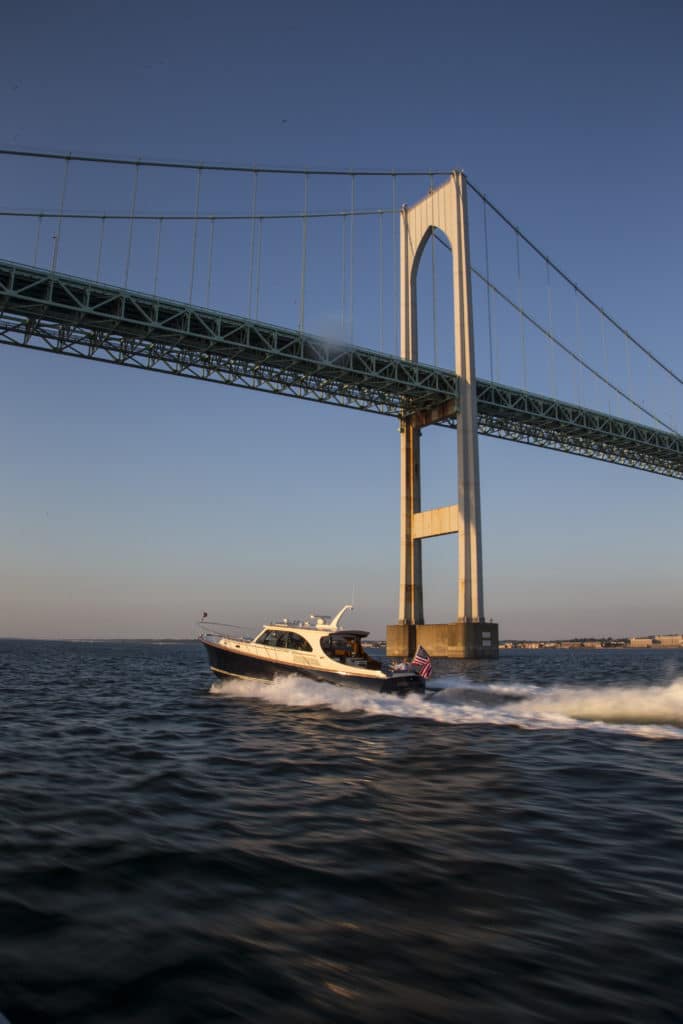
While touring the Hinckley yard, I asked how much time the company spent prototyping before building the first Talaria 43. The answers were surprising. “In this market segment, it’s impractical to build prototypes,” says Hinckley’s product development director, John Donahue. “Instead, we depend on full-size mock-ups. Designing the hull strictly in computer aided design [CAD] software is a comfortable process, but dealing with the nuances of deck and interior layouts in CAD is not enough. We decided that we wanted the human factors experience, walking through and sitting in the space. It’s a unique perspective, and the amount of refinement you can accomplish is amazing.”
Burr Shaw, Hinckley’s chief engineer, agrees. “We learn a lot from the mock-ups,” he says. “Building a yacht in 3-D on a computer display gives you a real good idea of the aesthetic and the spaces involved, but nothing substitutes being able to actually stand in the space. Headroom is headroom, but there is an actual feel for how it all works together that can only be realized in the mock-up. The light, the way things flow.”
Hinckley has produced a four-minute video that shows Vice President and Chief Operating Officer Mike Arieta in the full-size mock-up, and clips from the production line. Watching Arieta in the salon of the mock-up instantly connected with my memory of the spaces and furnishings that worked so well together there. Despite the time and cost incurred, building the yacht’s mock-up is just one more example of Hinckley’s team — designers, engineers, craftsmen, administrators — getting the details right.









